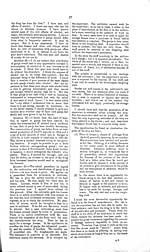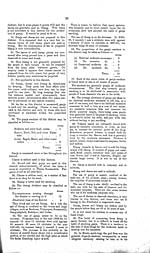Medicine - Drugs > Report of the Indian Hemp Drugs Commission, 1894-1895 > Volume IV
(42) Volume 4, Page 28
Thumbnail gallery: Grid view | List view

28
Therefore the most
complete system would be
to have a public gola. There are none provided.
I do not recommend them, because the custody of
the stuff would be in the hands of Government
officers and subordinates. They would not take
care of the stuff as the owners would. No doubt
a well-built Government gola would be safer both
from vermin and from abstraction than the houses
of the cultivators. I do not think there would be
any great difficulty if there were several Govern-
ment golas situated in central places; but I do
not think the cultivators would view the change
with favour. They would require to have access
to the stuff from time to time. If the stuff were
weighed and registered and put in a secure place,
the cultivator would not want to see it often. He
would want to see it two or three times a week in
wet weather. I see no great objection to the plan.
The concentration of the market would also be a
great advantage. The initial expense is a great
objection, unless it is believed that much is ab-
stracted. I do not think there is much pilfering;
but I have no data of course. I do not think the
expenditure on buildings and establishment would
be recouped by the prevention of such pilfering as
takes place. At the same time you cannot have
a perfect system without Government golas.
At present some believe
that wholesale vendors
make high profits, and that retail vendors are in
the dark when bidding at auction owing to the
ignorance of what they will have to pay for the
stuff. I do not think myself that the wholesale
vendor has too much profit in view of his expenses
and the risks of the trade, because I have estimat-
ed that his net profits are only from Rs. 10. to Rs.
15 a maund on a average throughout the province.
His expenses are in transport, buildings and estab-
lishments, and the risk of expenditure on the duty
on waste above the allowed percentage is great.
As to the retail vendor, of course he does not know
what price he has to pay for the stuff, but it is a
speculation, and I see no reason why Government
should interfere. He knows his own business.
There is nothing to prevent a retail vendor going
to Naogaon to buy ganja if he has a wholesale
gola in the importing district. He must have
this, or where can he take the ganja ? A retail
vendor, to deal direct with the cultivator, must
become also a wholesale vendor. And I have no
doubt that there are cases where the wholesale dealer
has the monopoly of the retail trade as well,
i.e.,
where the whole ganja trade is in the hands of a
syn-
dicate. I have my attention drawn to Rule 27 of Sec-
tion XX of the Manual. But it contemplates a
warehouse. I have no doubt this means a wholesale
storehouse in the importing district. Therefore the
retail vendor must be a wholesale vendor before he
can purchase direct. The retail dealer can go to
any wholesale dealer. At the head-quarters of my
district there are three wholesale dealers. There
would thus be competition. This is, of course,
liable to combination. I think the retail vendor
can go to the wholesale dealer of any district.
This is contemplated by Rule 60 of Section XX
of the Manual. The income from retail licenses
has increased steadily. This indicates that the
retail licensee makes a profit. I do not think
that they are at the mercy of the wholesale
dealers, because combination would be difficult
among the wholesale vendors of a district. And
in any case I see no reason for interference. The
rise in retail license fees is due, no doubt, really
in large measure to the rise in the price charged
for the drug to consumers.
At the same time the
retail vendors are in the
dark as to the price of the drug when they bid; and
the wholesale vendors have better opportunities of
knowing what the price will be than the retail
vendors can have. For it is the wholesale vendors
who go to the ganja-producing tracts and do
business there.
The present system
affords no criterion of the
profits received by the wholesale vendor, except
by particular enquiry in each case as to prices and
expenses. At present wholesale goladars are
appointed on application. I do not think any one
would be refused who made satisfactory arrange-
ments. I know in my district there are eight;
and I should say that was a very small number
as compared with other districts. All the work
could be done by one man if he had a monopoly.
Explanatory statement
submitted by
MR. PRICE.
I said in my evidence
that the cultivators would
view the introduction of the system of public
golas into the ganja tract with disfavour; they
would want to inspect and exhibit their stocks
three or four times a week. They would want
this for some time at first, in their desire to
dispose of their stocks. Intending purchasers
would not buy without inspection, and it is quite
possible that on many days the ganja would be
required to be exhibited several times a day to
intending purchasers. In any case I am quite sure
that a cultivator would wish to view his stock very
much oftener than twice or thrice a week when
it is stored in a public gola. I omitted to mention
this cause of constant inspection when I was being
examined.
10. Evidence of MR. F. H. BARROW, Magistrate and Collector of Bankura.
1. The answers are
prepared chiefly by Babu
Bhuban Mohan Raha, a retired Deputy Collector,
who long held charge of the Excise Department
in this district.
2. The definitions of
ganja, siddhi or bhang and
charas given in the question apply to this district.
In this district only two kinds of ganja, viz.,
round
and chur, are consumed.
3. The spontaneous growth
of the hemp plant
is not allowed in this district; sometimes it grows
spontaneously if seeds fall in moist places; but
such instances are very rare. It grows wild and
abundantly in the districts of Dacca and Faridpur,
and similar districts of which the soil is damp.
4. The wild plant which grows here is called
siddhi. Only one kind of wild plant grows.
5. A damp
climate and moist soil are favourable
to the growth of the wild hemp plant.
6. Ordinarily
the growth of the wild hemp is
dense. This remark applies to the districts where
it grows. Not of course to this, where it grows
only sporadically.
7 to 13. Do not apply to
this district. The
hemp plant for ganja is not cultivated in this
Set display mode to: Large image | Zoom image | Transcription
Images and transcriptions on this page, including medium image downloads, may be used under the Creative Commons Attribution 4.0 International Licence unless otherwise stated. ![]()
| India Papers > Medicine - Drugs > Report of the Indian Hemp Drugs Commission, 1894-1895 > Volume IV > (42) Volume 4, Page 28 |
|---|
| Permanent URL | https://digital.nls.uk/74552334 |
|---|---|
| Description | Evidence of Bengal witnesses. |
| Description | Volume 4: Evidence of witnesses from Bengal and Assam. |
|---|---|
| Attribution and copyright: |
|




